2.1 Networks 网络
Network Devices 网络设备
世界上最早的计算机网络之一是 1970 年美国的高级研究计划署网络(Advanced Research Projects Agency Network, ARPAnet,阿帕网),它是世界上第一个广域网(Wide Area Network, WAN)。到了 80 年代,随着个人电脑的普及,一种本地网络出现了,叫作局域网(Local Area Network, LAN)。90 年代以来,城域网(Metropolitan Area Network, MAN)也出现了,它的规模介于 LAN 和 WAN 之间。
Note
Network: A linked set of two or more computer systems, which may be capable of sharing computer resources such as printers, CD-ROM and databases.
WAN: Wide Area Network, network covering a very large geographical area. Covers 100 km to over 1000 km.
MAN: Metropolitan Area Network. Covers 1 km to 100 km.
LAN: Local Area Network, network covering a small area such as a single building. Covers 10 m to 1000 m.
PAN: Personal Area Network. Covers 1 m to 10 m.
If a number of computers and devices are joined together using a hub or switch, they can form a LAN.
If a number of LANs are joined together using a router or modem, they can form a WAN.
用网络连接设备和电脑的优点:
Devices, such as printers, can be shared (thus reducing costs).
Licenses to run software on networks are often far cheaper than buying licenses for an equivalent number of stand-alone computers.
Users can share files and data.
Access to reliable data that comes from a central source, such as a file server.
Data and files can be backed up centrally at the end of each day.
Users can communicate using email and instant messaging.
A network manager can oversee the network and, for example, apply access rights to certain files, or restrict access to external networks, such as the internet.
用网络连接设备和电脑的缺点:
Cabling and servers can be an expensive initial outlay.
Managing a large network can be a complex and difficult task.
A breakdown of devices, such as the file servers, can affect the whole network.
Malware and hacking can affect entire networks (particularly if a LAN is part of a much larger WAN), although firewalls do afford some protection in this respect.
网络根据归属可以分为 公共网络(Public Networks)和 私人网络(Private Networks)。
Public networks are owned by a communications carrier company.(举例:telecoms company,通常访问不受限,但公网的子网可能受安全监管)
Private networks are owned by a single company or organisation.(通常为 LAN,而且访问受限,比如需要用户名和密码来联网)
Note
电脑在 WAN 中的优点:
'job' could be run on a remote computer that had the required application software.
Data archive that was stored on a remote computer could be accessed.
A message could be transmitted electronically to a user on a remote computer.
WAN 的性质:
It will be used by an organization or a company to connect sites or branches.
It will not be owned by organization or company.
It will be leased from a public switched telephone network company (PSTN).
A dedicated communication link will be provided by the PSTN.
Transmission within WAN will be from switch to switch.
Switch will connect WAN to each site.
There will not be any end-systems connected directly to WAN.
WANs have slowest data communication rates and largest distances could be thousands of kilometres apart.
电脑在 LAN 中的优点:
Expense of installing application software on each individual PC could be saved by installing software on an application server attached to LAN instead.
Allow sharing of file. File server could be attached to LAN that allowed users to store larger files and also allowed files to be shared between users.
Allow sharing of resources. Instead of supplying individual printers to be connected to a user's PC, one or more printers could be attached to print server that was connected to LAN.
Allow Central Management e.g backup / security.
Managers in organizations could use electronic mail to communicate with staff rather than sending round memos on paper.
'Paper-less office’ became a possibility, where files were to be stored in digital form on a file server rather than as paper copies in a filing cabinet.
LAN 的性质:
It will be used by an organization or a company within a site or branch.
LAN Cover small geographical area.
LAN will contain a device that allows connection to other networks.
There will be end-systems connected which will be user systems or servers.
无线局域网(Wireless LANs, WLAN):LANs with no wires or cables, provides wireless network communications over short distances (up to 100 m) using radio wave or infrared signals.
无线局域网需要无线接入点(Wireless Access Points, WAPs),简单来说,无线接入点就是和其他设备进行无线信息交换的设备,并将交换得到的数据通过有线连接的方式传入 LAN 中。
例 1:
(a) Explain the differences between LAN, MAN and WAN.
(b) Give two advantages and two disadvantages of networking computers.
解答:
(a) A LAN covers a small geographical area, such as a single building or campus (10 m ~ 1000 m). A WAN covers a large geographical area (100 km ~ over 1000 km). A MAN covers a larger area than a LAN but is smaller than a WAN (1 km ~ 10 km).
(b) 点击跳转到答案,从优点和缺点中各选两条即可。
在网络中,设备之间有不同的连接方式和配置方式。
Client-Server Model(客户端 - 服务器模型)
以下将客户端 - 服务器模型简称为 CSM. CSM 使用独立专用服务器和特定客户端工作站来组成网络结构。客户端(Client)电脑会连接到 服务器(Server)电脑上。
Note
Client-Server
Network that uses separate dedicated servers and specific client workstations.
All client computers are connected to the dedicated servers.
CSM 的性质:
Users are able to access most of files, which are stored on dedicated servers.
Server dictates which users are able to access which files. (Note: sharing of data is most important part of the client-server model.)
Client-server model allows installation of software onto a client's computer.
The model uses central security databases which control access to the shared resources. (Note: passwords and user lDs are required to log into the network.)
Once a user is logged into the system, they will have access to only those resources and files assigned to them by the network administrator, so offers greater security than peer-to-peer networks.
Client-server networks can be as large as you want them to be and they are much easier to scale up than peer-to-peer networks.
A central server looks after the storing, delivery and sending of emails.
Client-server model offers most stable system, for example, if someone deletes a shared resource from server, back-up would restore deleted resource.
Client-server network can become bottlenecked if there are several client requests at time.
在 CSM 中,通常会使用文件服务器(File Server)。
Note
文件服务器的作用:
Central storage and management of data files, thus enabling other network user so access files.
Allowing users to share information without the need for offline devices. (such as a memory stick)
Allowing any computer to be configured as host machine and act as file server. (note that server could be a storage device (such as SSD or HDD) that could also serve as a Remote Storage device for other computers, thus allowing them to access this device as if it were a local storage device attached to their computer).
下图是 CSM 的网络结构示意图:
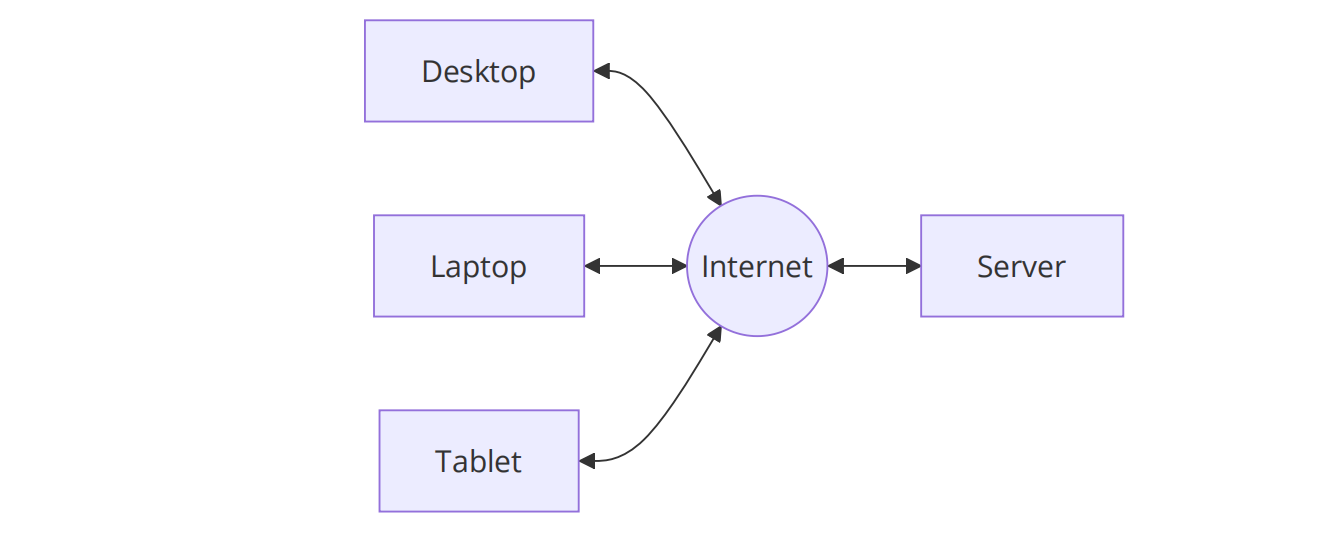
Peer-to-peer Model (P2P 模型)
以下将 Peer-to-peer Model 简称为 P2P.
Note
Peer-to-peer
Network in which each node can share its files with all other nodes.
Each node has its own data and there is no central server.
Because there is no central storage, there is no requirement to authenticate users.
节点(Node)是连接到 P2P 网络中的设备,可以是电脑或其他独立设备。
P2P 网络的性质:
On a Peer-To-Peer network, each node joins network to allow Provision of Services to all other network users;
Services available are listed on nominated “look up” computer. When a node requests a service, “look up” computer is contacted to find out which of other network nodes can provide required service.
Other users on network to simply access data from another node.
Communication with other peers connected to network.
Peers to be both suppliers and consumers (unlike client-server model where consumers and resources are kept entirely separate from each other).
Peers to participate as equals on network (this is different to client-server model where a webserver and client have different responsibilities).
P2P 网络的应用场景:
Peer to Peer model is used in scenarios where few number of nodes are required (small business) where it is relatively easy for users to be in contact with each other. More number of nodes leads to performance and management issues.
下图是 P2P 的网络结构示意图:

P2P 网络的优点:
It avoids possibility of congestion on network when many clients are simultaneously attempting to download files;
Parts of a file can be downloaded separately;
Parts are available from more than one host.
CSM 网络的优点:
It allows an organisation to control downloading and use of files.
Files can be better protected from malware attacks because files are stored on one server which will be regularly scanned using appropriate anti-virus software.
P2P 网络的缺点:
No central management of security;
No central management of backup;
No central management of files / software;
Individual computers may respond slower;
In order to share files all the computers involved need to be switched on.
CSM 网络的缺点:
If the server goes down then all the devices cannot work;
The start-up cost are higher than peer-to-peer model.
在 CSM 网络中,我们将客户端分为不同的种类。
Thin Client and Thick Client 瘦客户端与厚客户端
Thin Client 瘦客户端
Note
Thin Client: Device that needs access to the internet for it to work and depends on a more powerful computer or server for processing.
Thin Client 的特点:Thin client will not work unless it is connected at all times to computer or server. Only provides input and receives output (no local storage)
Thin Client 举例:
Software 的例子:Web browser (has very little functions unless it is connected to a server)
Hardware 的例子:POS Terminal (needs constant access to server to do any significant processing)
Thin Client 的优点:
Less expensive to expand; (low powered and cheap devices can be used)
All devices are connected to a server; (data updates and new software installation are done centrally)
Server can offer protection against hacking and malware.
Thin Client 的缺点:
High reliance on the server; if the server gets down or there is a break in communication link then all the devices cannot work;
Despite cheaper hardware, the start-up costs are generally higher than for thick client.
Thick Client 厚客户端
Note
Thick Client: Device which can work both offline and online and is able to do some processing even if not connected to a network / internet.
Thick Client 的特点:Carries out some processing OR downloads the software and runs it itself; Clients do most of their own processing independently
Thick Client 举例:
Software 的例子:Computer Game (has its own storage, RAM and operating system)
Hardware 的例子:Normal PC / Laptop (needs constant access to server to do any significant processing)
Thick Client 的优点:
More robust; Device can carry out processing even when not connected to a server;
Clients has more control; (they can store their own programs and data / files)
Thick Client 的缺点:
Less secure; (relies on clients to keep their own data secure)
Each client needs to update data and software individually;
Data Integrity issues as many client access same data which can lead to inconsistencies.
Note
Thin Client 和 Thick Client 的区别:
(Server) Thin client always relies on a connection to a remote server or computer for it to work, while thick client can run some of the features of the software even when not connected to a server;
(Local Resource) Thin client requires very few local resources while thick clients relies heavily on local resources;
(Network) Thin client relies on a good, stable and fast network connection for it to work while thick clients are more tolerant of a slow network connection;
(Data) In thin clients, data is stored on remote server or computer while in thick clients can store data on local resources such as HDD or SSD.
例 2:
(a) Network runs as thick-client model, describe what is meant by a thick-client model.
(b) Melinda and her friends set up a peer-to-peer network between their computers to share data.
(i) Describe the key features of a peer-to-peer network.
(ii) Describe two drawbacks to Melinda and her friends of using a peer-to-peer network.
解答:
(a) Device which can work both offline and online and is able to do some processing even if not connected to a network / internet.
(b)
(i) Device which can work both offline and online and is able to do some processing even if not connected to a network / internet.
(ii) 点击跳转到答案,从缺点中选两条即可。
Data Transmission 数据传输
Types of Transmission Mode on Bases of Direction of Data 基于数据方向的传输模式类型
根据数据方向,我们可以把数据传输模式分为单工数据传输(Simplex Data Transmission, SDT)、半双工数据传输(Half-Duplex Data Transmission, HDDT)、全双工数据传输(Full-Duplex Data Transmission, FDDT)三种。
Note
SDT: One direction data transmission from transmitter to receiver.
SDT 举例:
Data from keyboard to CPU;
Data from a computer to a printer;
Television or radio.
HDDT: Both directions but not at the same time.
HDDT 举例:Walkie-talkie(对讲机)。
FDDT: Both directions simultaneously.
FDDT 举例:
Telephone;
Communication between website and user;
Types of Message 消息类型
根据范围的不同,我们把消息类型分为 单播(Unicast)、多播(Multicast)和广播(Broadcast)三种。
Note
Unicast Message: Communication technique in which data transmission is done between two devices.
别名:One-to-one Communication 或 Point-to-point Communication.
Unicast Message 举例:Communication between server and client.
Multicast Message: Communication technique in which data transmission is done between a particular group of devices.
Multicast Message 举例:Group message sent through SMS; Sending email to a particular mailing group.
Broadcast: Communication technique in which a piece of information is sent from one point to all other points.
Broadcast 举例:Emergency alarm system.
Network Topologies 网络拓扑结构
有很多种方式来把设备连接为复杂的网络。AL 中涉及的有:总线网络(Bus Networks)、星形网络(Star Networks)、网状网络(Mesh Networks)、混合网络(Hybrid Networks)。
在所有复杂的网络结构之前,最简单的网络结构叫作点对点连接(Point-to-point Connection),只是将两个终端(End-System)简单地连接到网络链路里。点对点连接可能是单工或双工通信,但发送的消息一定是单播的。
总线网络 Bus Networks
总线网络只有一个 链路(Link),但是它被数个终端共享,所以它是一种多点连接(Multi-point Connection)。无法在一对终端之间建立直接的连接,发出的消息只能是广播(也就是发信给所有终端,尽管可能只需要向一个终端发信)。总线网络的韧性非常好,因为网络或设备的断点不会影响其他终端使用网络。
Note
Bus Topology: Network topology has only one link but it is shared by number of end-systems.
Bus Topology 的性质:
It is a multi-point connection;
A message must be broadcast even though it might only be intended for one end-system;
It is resilient. (原因:a fault in an end-system or in the link to it does not affect the use of the network by the other end-systems)
Bus Topology 的优点:
Even if one node fails, the remainder of the network continues to function;
It is easy to increase the size of the network by adding additional nodes.
Bus Topology 的缺点:
If main cable fails, whole network goes down;
Performance of the network declines under heavy loading;
Network is not secure since each packet passes through every node.
Bus Topology 的数据传输逻辑: In bus network topology, each node looks at each packet and determines whether or not the address of the recipient in the package matches the node address. If so, the node accepts the packet; if not, the packet is ignored.
网状网络(Mesh Networks)
网状网络有很多链路,每个终端之间都有链路进行连接,每一对终端之间都有点对点连接;数据传输是双工的;消息可以以单播、多播或广播的形式发送。
Star Topology:
All devices are connected to a central hub or switch.
Packet Transmission: Data is sent from the source to the hub, which then forwards it to the intended destination.
Advantages: Easy to manage, isolate faults, and offers dedicated connections for each device.
; higher cabling costs.
Note
Mesh Topology: Network topology that each end-system has a point-to-point connection to each of the other end systems.
Mesh Topology 的性质:
Transmission is duplex;
Messages might be unicast, multicast or broadcast.
Mesh Topology 的优点:
It is easy to identify where faults on the network have occurred;
Any broken links in the network do not affect the other nodes;
The network is relatively easy to expand.
Mesh Topology 的缺点:
Large amount of cabling is needed, which is expensive and time consuming;
Set-up and maintenance is difficult and complex.
典型使用场景:Mesh topology is used when individual LAN switches are connected in a network.
星形网络(Star Networks)
星形网络中的每个终端都和中心设备建立点对点连接;数据传输是双工的;消息可以以单播、多播或广播的形式发送。
Note
Star Topology: Network topology that each end-system has a point-to-point connection to each of the other end systems.
Star Topology 的性质:
Transmission is duplex;
Messages might be unicast, multicast or broadcast.
Star Topology 的优点:
Data collisions are greatly reduced due to the topology;
More secure network since security methods can be applied to central node and packets only travel to nodes with correct address.
Star Topology 的缺点:
If central hub/switch fails, then whole network goes down;
Initial installation costs are high.
典型使用场景:Star Networks are useful for evolving networks where devices are frequently added or removed. They are well suited to applications where there is heavy data traffic.
混合网络(Hybrid Networks)
混合网络是两种及以上不同种类的拓扑逻辑(总线、星形、网状,etc.)的混合。它的优缺点取决于组成混合网络的各个拓扑逻辑的优缺点。但是所有的拓扑网络都有一个缺点:It is very complex to install, configure and maintain.
传输媒介(Transmission Media)
线缆(Cable)
AL 中涉及的传输线缆分为 双绞线(Twisted Pair Cable)、同轴电缆(Coaxial Cable)和 光纤电缆 / 光缆(Fibre-optic Cable)。
它们的优缺点如下:
| Twisted Pair | Coaxial | Fibre-Optic | |
|---|---|---|---|
| Cost | Lowest | Higher | Highest |
| Bandwidth or data rate | Lowest | Higher | Much Higher |
| Attenuation at high frequency | Affected | More Affected | Least Affected |
| Interference | Worst Affected | Less Affected | Least Affected |
| Need for repeaters | More Often | More Often | Less Often |
双绞线 Twisted Pair Cable
双绞线是 LAN 中最常用的线缆。
此处 AL 的说法已过时,但仍然按照此观点答题
Note
Types of Twisted Pair Cable:
无屏蔽层(Unshielded):Used by residential users;
有屏蔽层(Shielded):Used commercially.
Shielded 的好处:Cable Contains thin metal foil jacket which cancel out some of external interferences.
同轴电缆 Coaxial Cable
同轴电缆常用于 MAN,以及有线电视(Cable Television)的信号传输。
Cost of coaxial cables is higher than twisted pair cables but they offer better data transfer rate and are affected less by external interference.
Important
同轴电缆一般不用作长距离电话线(Long-distance Telephone Cable)。
光缆 Fibre-optic Cable
光缆分为两种:单模光缆(Single-mode Fibre-optic Cable)和多芯光缆(Multi-core Fibre-optic Cable)。
Note
Single-mode Fiber-optic Cable uses a single mode light source and has a smaller central core, which results in less light reflection along cable. This allows data to travel faster and making them a good choice for telecommunications.
Multi–core Fiber-optic Cable allows for multi-mode light source, construction causes higher light reflections in core, so they work best over shorter distances (in a LAN).
Note
选择不同线缆的因素:
Cost of cable and connecting devices.
Best bandwidth that can be achieved. Bandwidth governs possible data transmission rate.
造成线缆性能降低的原因:
Interference affecting transmitted signals.
Extent of attenuation (deterioration of signal) when high frequencies are transmitted.
无线传输(Wireless Transmission)
无线传输是用电磁波传播信息的方式。用于无线传输的电磁波主要有:无线电波(Radio)、微波(Microwave)和红外线(Infrared)。
它们的性质(箭头方向表示递增方向):
| Frequency range | Radio (3kHz–3GHz) | Microwave (3–300GHz) | Infrared (300GHz–400THz) |
|---|---|---|---|
| Bandwidth or data rate | -------> | ||
| Attenuation (mainly due to rain) | -------> | ||
| Need for repeaters | -------> | ||
| Directional focusing capability | -------> | ||
| Penetration through a wall | <------- | ||
| Interference | There is no systematic trend | ||
Note
Penetration: Ability of electromagnetic radiation to pass through different media.
Attenuation: Reduction in amplitude of a signal.
Tip
Infrared has very low attenuation so it is best suitable for indoor use only.
Bandwidth: Amount of data that can be transmitted per second.
Note
无线网络和有线网络分别的特点:
有线网络:
More reliable and stable network;
Data transfer rates tend to be faster;
Tends to be cheaper overall, in spite of the need to buy and install cable;
Devices are not mobile, they must be close enough to allow for cable connections;
Lots of wires can lead to tripping hazards, overheating of connections;
Permission from authorities and land owners is required before laying cables underground.
无线网络:
It is easier to expand networks and is not necessary to connect devices using cables;
Devices have increased mobility, provided they are within range of the WAPs;
Increased chance of interference from external sources;
Data is less secure than with wired systems; it is easier to intercept radio waves and microwaves than cables. Data transmission rate is slower than wired networks;
Signals can be stopped by thick walls.
Wi-Fi and Bluetooth
Wi-Fi and Bluetooth both use electromagnetic radiation as carrier of data transmission.
Note
蓝牙工作的原理与特点:
Bluetooth sends and receives radio waves in band of 79 different frequencies (channels).
Devices using Bluetooth automatically detect and connect to each other, but they do not interfere with other devices since each communicating pair uses different channel.
When a device wants to communicate, it picks one of 79 channels at random.
If channel is already being used, it randomly picks another channel, This is known as Spread Spectrum Frequency hopping.
Wi-Fi 工作的原理与特点:
Wi-Fi uses spread spectrum technology, Wi-Fi is best suited to operating full-scale networks, since it offers much faster data transfer rates, better range and better security than Bluetooth.
Wi-Fi-enabled device (computer or smart phone) can access internet wirelessly at any wireless access point (WAP) or 'hot spot' up to 100 m away.
卫星(Satellites)
Satellites are components of modern communication systems. Van Allen belts are areas containing high levels of electrically charged particles, which interfere with satellites.
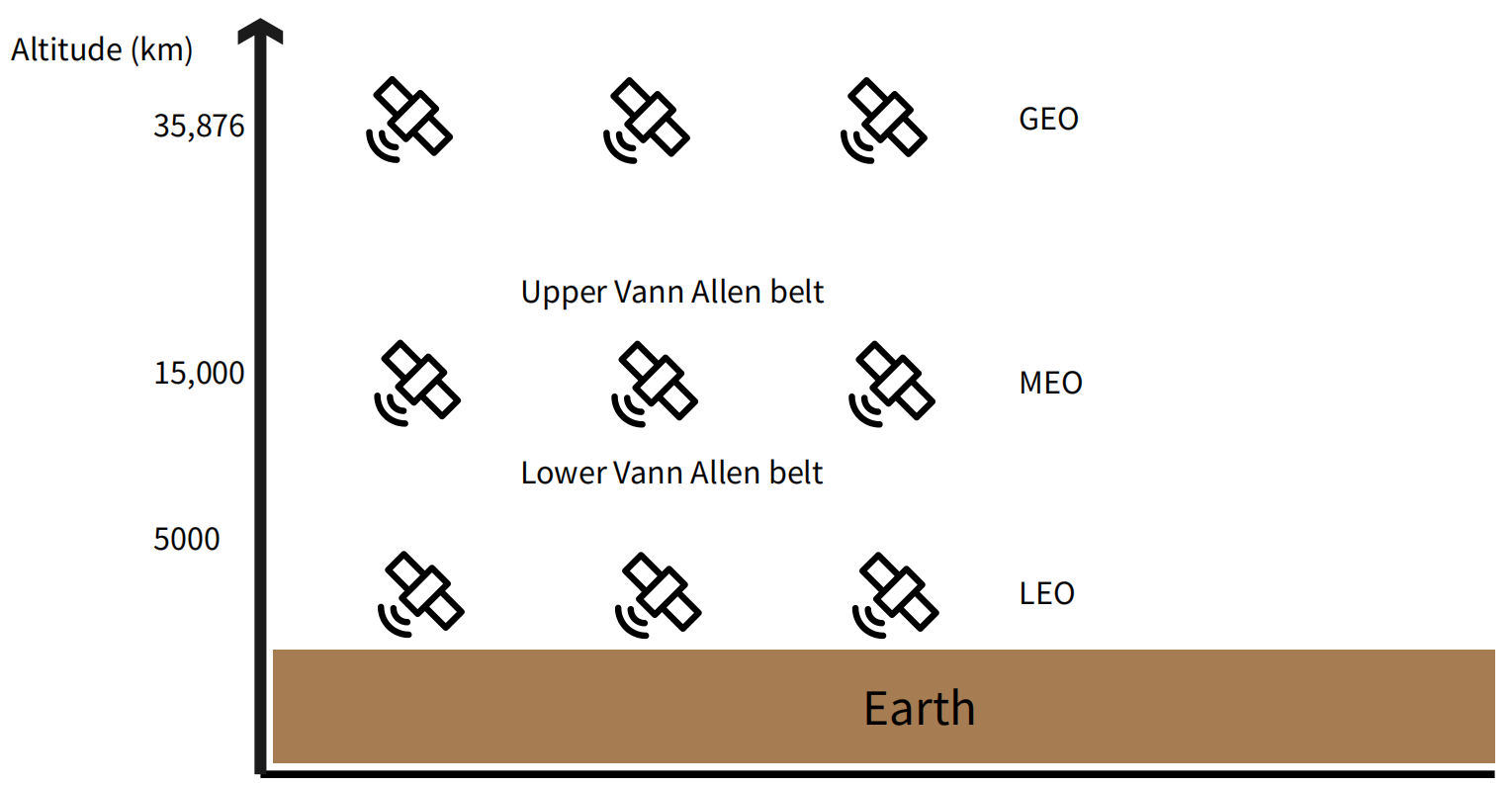
GEO Satellites: Highest altitude satellites are in geostationary Earth orbit (GEO) over equator and these are used to provide long-distance telephone and computer network communication. 'Geostationary' means that satellite orbits at same speed as Earth spins. Only 3 GEO satellites are needed for full global coverage.
MEO Satellite: Closer to Earth are a group of medium Earth-orbit (MEO) satellites some of which provide the global positioning system (GPs). 10 MEO satellites are needed for global coverage.
LEO Satellites: Low-Earth-orbit (LEO) satellites work in 'constellations' to supplement the mobile phone networks, 50 LEO satellites are needed for full global coverage but currently there are several hundred LEO satellites in orbit.
Note
卫星通信的缺点:The greater transmission distance causes transmission delays, which can cause technical problems for the network.
LAN 的硬件要求(Hardware Requirements of LAN Networks)
Note
集线器(Hub)
Hardware devices that can have a number of devices or computers connected to them;
Take any data packet received at one of its ports and then send the data to every computer in the network.
Using hubs is not a very secure method of data distribution and is also wasteful of bandwidth.
Hubs can be wired or wireless devices.

交换机(Switch)
Hardware devices that can have a number of devices or computers connected to them;
Directs incoming data packets to a specific destination address only.
Switch is more secure and efficient of distributing data.

中继器(Repeater)
Hardware devices which are added to transmission systems to boost the signal so it can travel greater distances.
用中继器的原因:When signals are sent over long distances, they suffer attenuation or signal loss.
Repeaters amplify signals on both analogue (copper cable) and digital (fibre optic cable) communication links.
Repeaters are used to boost signals to prevent any ‘dead spots’ in the Wi-Fi zone.
Repeater 可以内置在 Hub 里,结合而成的设别叫作 中继集线器(Repeating Hub),既放大信号又发送给所有其它设备。
网桥(Bridge)
Hardware devices that connect one LAN to another LAN that uses same protocol.
Often used to connect together different parts of a LAN so that they can function as a single LAN.
Bridge stores network addresses for end-systems in two segments it connects.
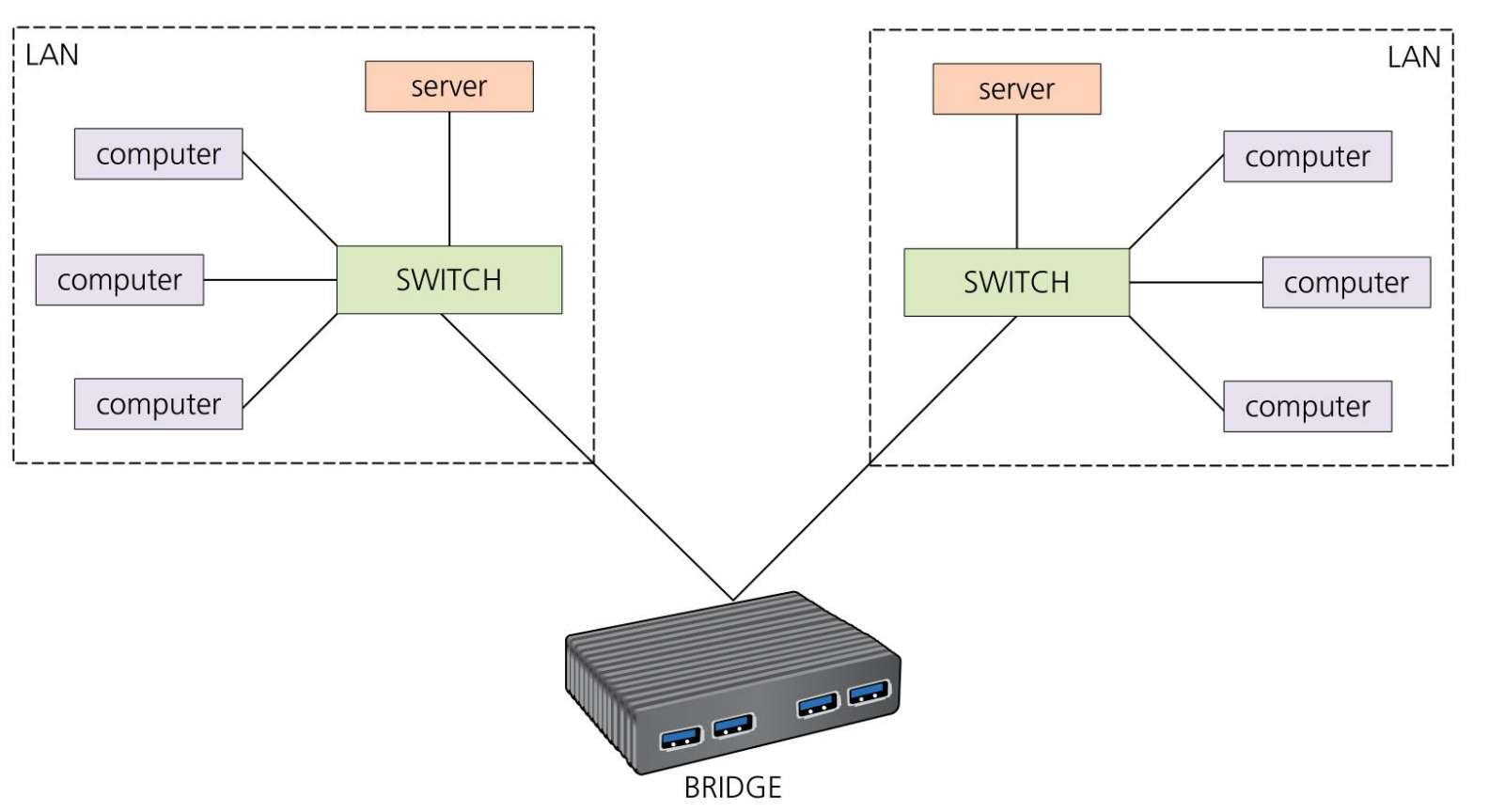
路由器(Router)
Hardware device which enables data packets to be routed between different networks (for example, can join LANs to form a WAN).
Takes data transmitted in one format from a network and converts data to a protocol and format understood by another network thereby allowing them to communicate via router.
路由器工作流程:
Restrict broadcasts to a LAN;
Act as a default gateway;
Can perform protocol translation;
Can move data between networks;
Can calculate best route to a network destination address.
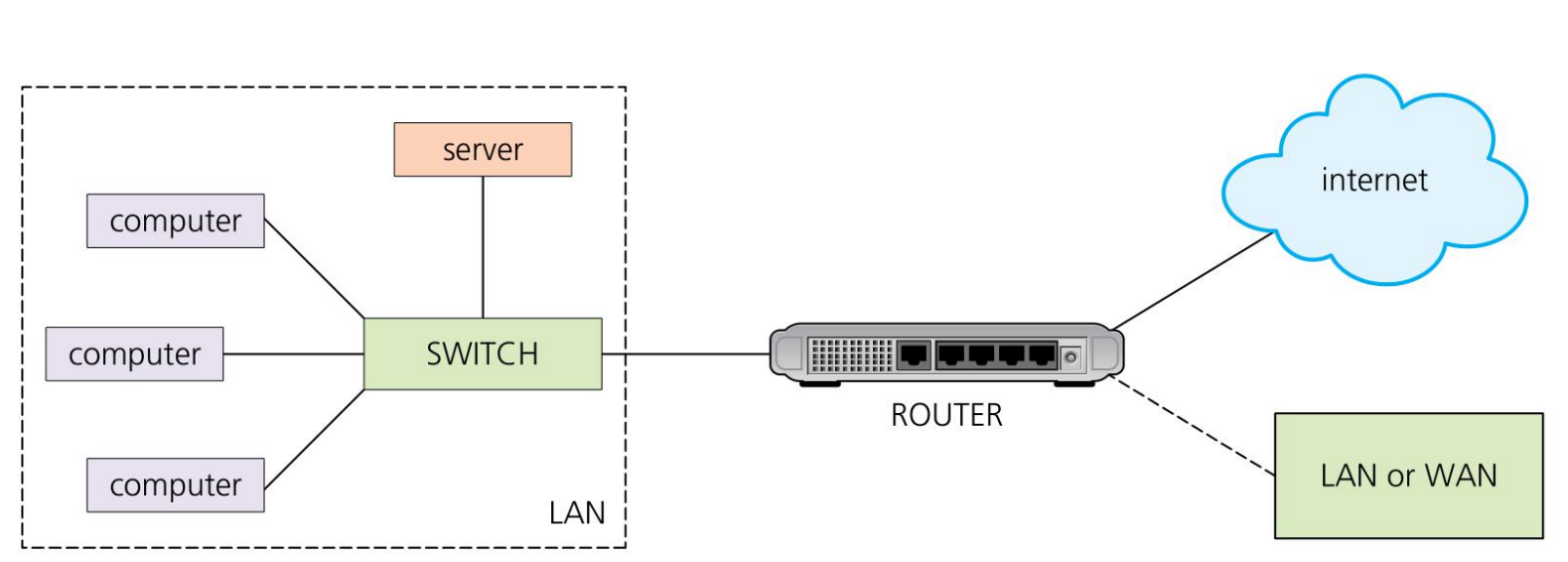
网关(Gateway)
Network point that acts as an entrance to another network.
Converts data packets from one protocol to another.
Any device that allow traffic to flow I/O of the networks can be a gateway.
路由器和网关的区别:
| Routers | Gateways |
|---|---|
| forward packets of data from one network to another; routers read each incoming packet of data and decide where to forward the packet | convert one protocol (or data format) to another protocol (format) used in a different network |
| can route traffic from one network to another network | convert data packets from one protocol to another; they act as an entry and exit point to networks |
| can be used to join LANs together to form a WAN (sometimes called brouters) and also to connect a number of LANs to the internet | translate from one protocol to another |
| offer additional features such as dynamic routing (ability to forward data by different routes) | do not support dynamic routing |
调制解调器(Modem)
Modulator demodulator;
Hardware device which converts digital data to analogue data (to be sent down a telephone wire);
Conversely it converts analogue data to digital data (which a computer can process).
Wireless modems transmit data in a modulated form to allow several simultaneous wireless communications to take place without interfering with each other.

网络接口卡 / 网卡(Network Interface Card / NIC)
NIC is usually part of the device hardware and frequently contains the MAC address generated at the manufacturing stage.
无线网卡(Wireless Network Interface Card / Controller, WNIC): WNICs are used to connect devices to internet or other networks. They use an antenna to communicate with networks via microwaves and normally simply plug into a USB port or can be internal integrated circuit plug in.
云计算(Cloud Computing)
Note
Cloud storage is method of data storage where data is stored on offsite servers. Physical storage covers hundreds of servers in many locations. Instead of saving data on a local hard disk, a user can save their data 'in the cloud'.
Data Redundancy: The same data is stored on more than one server in case of maintenance or repair, allowing clients to access data at any time.
云存储 / 云计算的类型:
公共云(Public Cloud): A storage environment where the customer/client and cloud storage provider are different companies.
私有云(Private Cloud): Storage provided by a dedicated environment behind a company firewall. Customer/client and cloud storage provider are integrated and operate as a single entity.
混合云(Hybrid Cloud): A combination of private and public clouds. Some data resides in the private cloud and less sensitive/less commercial data can be accessed from a public cloud storage provider.
使用云存储的优点:
Customer / Client files stored on the cloud can be accessed at any time from any device anywhere in the world provided internet access is available;
No need for a customer / client to carry an external storage device with them, or use the same computer to store and retrieve information;
Provides the user with remote back-up of data to aid data loss and disaster recovery;
Recovers data if a customer/client has a hard disk or back-up device failure;
Offers almost unlimited storage capacity.
使用云存储的缺点:
If the customer / client has a slow or unstable internet connection, they would have problems accessing or downloading their data / files;
Costs can be high if large storage capacity is required;
Expensive to pay for high download/upload data transfer limits with the customer / client internet service provider (ISP);
Potential failure of the cloud storage company is possible.
云软件(Cloud Software)
Note
Cloud Software: Software applications can be delivered to user's computer on demand using cloud computing services.
Cloud provider will both host and manage software applications- this will include maintenance, software upgrades and security for monthly fee.
User will simply connect to internet and contact their cloud services supplier. Cloud services supplier will connect them to software application they require.
使用云软件的优点:
Software will be fully tested and it does not need to reside on user's device;
User can still use software even if internet connection is lost;
Data will simply be stored on local device and then data will be uploaded or downloaded once internet connection is restored.
以太网(Ethernet)
Ethernet is a protocol used by many wired LANs.
It was adopted as a standard by the Institute of Electrical and Electronic Engineers (IEEE) and Ethernet is also known as IEEE 802.3.
Note
以太网的组成:
a node (any device on the LAN);
medium (path used by the LAN devices, such as an Ethernet cable);
frame (data is transmitted in frames which are made up of source address”and destination address -the addresses are often the MAC address).
使用以太网的优点:
Cost-effective, Ethernet is relatively inexpensive compared to other systems of connecting computers;
More stable, secure, reliable and consistent than Wi-Fi;
Fast data transfer;
Simple and easy to maintain.
当使用以太网时,IP 地址有可能发生 冲突(Conflict)。
Note
冲突发生的条件:Devices on same network have been given same IP address.
常见的冲突(动态 IP 冲突):A LAN where dynamic IP addresses may have been used. 解决方法:Re-start router, any dynamic IP addresses will be reassigned, which would solve issue.
以太网支持数据的广播,但是如果两条消息同时在同一个频道被发送,则会发生碰撞(Collision)。
Note
碰撞发生的条件:Two messages using same data channel be sent at the same time.
我们可以使用载波监听多路访问/碰撞检测(Carrier Sense Multiple Access with Collision Detection, CSMA/CD)协议来解决碰撞。
Note
CSMA/CD 协议的工作流程:
When a frame is sent it causes a voltage change on Ethernet cable;
When a collision is detected, a node stops transmitting a frame and transmits a 'jam' signal and then waits for a random time interval before trying to resend the frame;
CSMA/CD protocol will define random time period for a device to wait before trying again.
设备 A 监听信道 -> 空闲 -> 发送数据设备 B 监听信道 -> 空闲 -> 发送数据(与 A 冲突)碰撞发生!设备 A 和 B 停止发送,发送干扰信号设备 A 和 B 等待随机时间后重新尝试发送数据
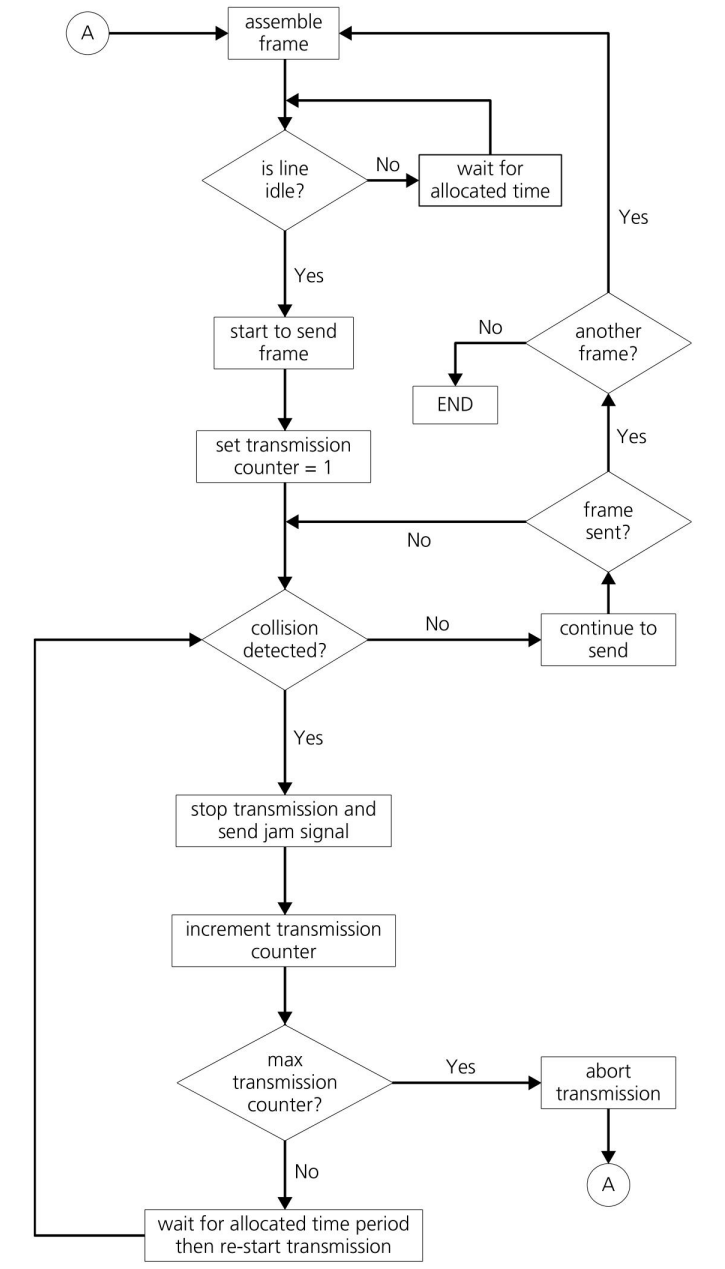
例 3:
(a) Explain the differences between public and private cloud computing;
(b) Give two benefits of using cloud storage;
(c) Give two drawbacks of using cloud storage.
解答:
(a) 公有云 term + 私有云 term + 比较
(b) 点击跳转到答案,选两条即可
(c) 点击跳转到答案,选两条即可
比特流传输(Bit Streaming)
Bit Streaming(比特流传输) 是一种数据传输模式,其中数据被连续地按位(Bit)或按包(Packet)发送,而不是以完整的数据块存储后再传输。这种方式通常用于流式媒体、实时通信、数字信号传输 等场景。
Note
比特流传输的特点:
Bit streaming is contiguous sequence of digital bits sent over internet that requires high speed data communication link (such as fast broadband);
Bit streaming often involves very large files (video) it is necessary for files to undergo some data compression before transmission;
Sequence of bits will be transmitted continuously over a single channel;
Bits are transmitted serially, one after other;
Videos are stored on media server;
During downloading process, server send data to client computer in a buffer;
Software (media player) will receive bits stream from buffer.
缓冲区(Buffer):A temporary storage area of computer.
比特流传输视频文件时,缓冲区的作用:
Data transmission rate from file server (containing video) to buffer must be greater than rate at which data is transmitted from buffer to media player;
Larger the buffer, better the control over the bit rate being sent to media player;
Media player will always check to ensure data lies between a minimum value (low water mark) and a maximum value (high water mark).

比特流传输的优点:
No need to wait for a whole video or music file to be downloaded before user can watch;
No need to store large files on your device;
Allows video files and music files to be played on demand;
No need for any specialist hardware;
Affords piracy protection because it is more difficult to copy streamed files than files stored on a hard drive.
比特流传输的缺点:
Cannot stream video or music files if broadband connection is lost;
Security risks associated with downloading files from the internet;
Streaming uses up a lot of bandwidth;
Video files will pause to allow data being streamed to 'catch up' if there is insufficient buffer capacity or slow broadband connection.
比特流传输可以是按需传输(On Demand)的,也可以是实时传输(Real Time)的。
Note
按需比特流传输的定义:Process of transmitting digital data that are stored on a server in a continuous bit stream format, allowing users to access and control playback as needed.
按需比特流传输的特点:
Digital files stored on a server are converted to a bit streaming format;
A link to the encoded video / music file is placed on the web server to be downloaded;
URL of encoded video file is placed on web server to be downloaded.
The user clicks on URL and the video / music file is downloaded in a contiguous bit stream;
Because it is on demand, the streamed video / music is broadcast to the user as and when required;
It is possible to pause, rewind and fast forward the video / music if required.
实时比特流传输的定义:Process of transmitting digital data in a continuous stream over internet without storing data on a server.
实时比特流传输的特点:
An event is captured by camera and microphone and is sent to a computer;
The video signal is converted (encoded) to a streaming media file;
The encoded file is uploaded from the computer to the dedicated video streaming server;
The server sends the encoded live video to the user's device;
Since the video footage is live it is not possible to pause, rewind or fast forward.
比特流传输中,传输速率的重要性:
When media is created it is intention that media is to be delivered to user at same speed as used for its creation.
Process of delivering content is determined by bit rate.
Rate of transmission to buffer is limited by bandwidth of network connection.
It is essential to have a buffer size that is sufficiently large for it never to get filled.
波特率(Baud Rate):Number of signal units transmitted per second and one signal unit is able to represent one or more bits.
比特率的计算公式:
练习 1
(a) In one of a company's offices, one server and four computers connected in a star topology. Draw a diagram to show layout of office's star topology.
(b) Explain how cloud computing can be beneficial for collaborative projects. Include specific features that facilitate collaboration.
(c) Describe the process of collision detection and management in Ethernet networks using the CSMA/CD protocol.
最后编辑:admin 更新时间:2025-03-17 12:29
